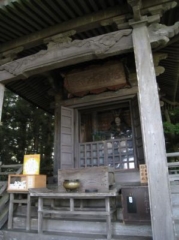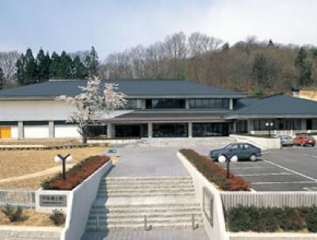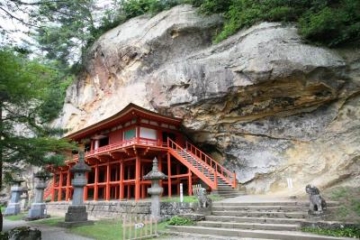MODEL COURSE
Hiraizumi Station
5 minutes
Iwate Prefectural Hiraizumi World Heritage Guidance Center
3 minutes
Muryokoin Ruins [World Heritage Site]
![Muryokoin Ruins [World Heritage Site]](https://iwatetabi.jp/wp/wp-content/uploads/2024/03/1679-309x240.jpg)
Muryoko-in Temple, built by the third generation Hidehira, is modeled after the Phoenix Hall at Uji Byodo-in Temple. Hidehira Temple was adjacent to the Garan Imperial Palace, where he lived. Most of the ruins have been turned into rice paddies, but the ruins of the pond, Nakajima, and temple foundation still remain. According to the results of the excavation survey conducted in 1955, it was a magnificent temple, with the axis of the temple running from east to west passing through the east gate, bridge, middle island, and bridge hall, and beyond which one could see Mt. Kinkeizan. It is known that
Detailed Destination Information3 minutes
Takadate Gikeido

Takadachi is a hill located to the east of Chuson-ji Temple, and is also called Hangandate. Although it is now narrow due to erosion by the Kitakami River, this area has been considered a great strategic point since the Kiyohira era. At the top of Takadate is Yoshitsune Hall, which was built in 1683 by Sendai Date Tsunamura, and a statue of Yoshitsune is enshrined inside the hall. If you look at Takadate from the opposite bank of the Kitakami River, you will see Gikeido Hall on top of the hill surrounded by trees. It has an atmosphere as if Minamoto no Yoshitsune, the general of Hakko, is standing there.
Detailed Destination Information5 minutes
Chusonji Temple [World Heritage Site]
![Chusonji Temple [World Heritage Site]](https://iwatetabi.jp/wp/wp-content/uploads/2024/03/591-328x240.jpg)
Tendai sect, Tohoku Daihonzan. The name of the mountain is Kanzan, and Jikaku Daishi is the founder of the mountain.
At the beginning of the 12th century, the first Lord Kiyohira of the Oshu Fujiwara clan built many temples and pagodas, including the Tahoto and Nikai Daido.
Its purpose was to comfort the spirits of those who died in the long wars of the First Nine Years War and the Second Third Year War, and to build a Buddhist nation.
Unfortunately, the hall and pagoda were destroyed by fire in the 14th century, but it is still a treasure trove of Heian art, containing over 3,000 national treasures and important cultural properties, including the Kaneiroki Hall.
5 minutes
Hiraizumi Cultural Heritage Center

On April 14, 2009, Hiraizumi Town integrated the Hiraizumi Local Museum and the Town Cultural Heritage Center to open the Hiraizumi Cultural Heritage Center. As a guidance facility that provides an easy-to-understand introduction to Hiraizumi's cultural heritage, and as a visitor center for sightseeing in the town, it introduces a wide range of Hiraizumi's history and culture.
Detailed Destination Information3 minutes
Motsuji Temple [World Heritage Site]
![Motsuji Temple [World Heritage Site]](https://iwatetabi.jp/wp/wp-content/uploads/2024/03/2575-331x240.jpg)
Motsuji Temple, the special head temple of the Tendai sect, is called Iozan and was opened in 850 by Jikaku Daishi.
In the late Heian period, the Oshu Fujiwara clan's second and third generation, Motohira and Hidehira, built magnificent temples such as Kondo Enryuji and Kashoji, which numbered 40 halls and pagodas and 500 monks' quarters, making them the largest temple in Japan. It was called the second sacred place.
Unfortunately, the temple at that time was burnt down due to repeated disasters, but today the " Jodo Garden " centered around Oizumigaike Pond and the remains of the temple from the Heian period have been preserved in almost perfect condition, and the country has designated it as a special historic site. It has been designated as a scenic spot.
20 min
Dargakku Bishamon-do Hall

Even before Kiyohira settled in Hiraizumi, several temples had already been built in and around Hiraizumi. One of them is Saikoji Temple. According to the temple law, when Sakanoue Tamuramaro subdued Ezo, he built Bishamon-do Hall in imitation of Kyoto's Kiyomizu-dera Temple in gratitude for the blessings of Bishamonten, and built 108 Tamonten statues following Kurama-dera Temple. It is said that it began when the shrine was dedicated to The circumstances surrounding Ezo and Tamuramaro have become the subject of many stories and folklore, and they also add color to the temple legends of Saikoji Temple. Bishamondo was destroyed by fire twice, and the current one was rebuilt in 1963.
Detailed Destination Information25 minutes
Hiraizumi Station

![[Rental bicycle Rinrin] Hiraizumi town course](https://iwatetabi.jp/wp/wp-content/uploads/2024/03/3289.jpg)
![[Hiraizumi Loop Bus] ~Runrun~](https://iwatetabi.jp/wp/wp-content/uploads/2024/03/2422-360x240.jpg)